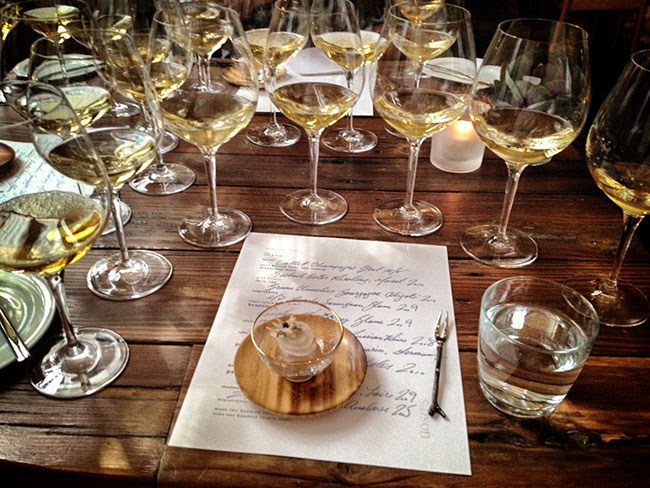I received an invite from a good friend to attend a blind 2008 Montrachet tasting and dinner at Saison Restaurant in San Francisco. Mark Bright, Saison’s sommelier, did an excellent job of providing us with some of the best wine service you could imagine. As previously stated, all wines were tasted blind from right to left (as pictured above) and decanted about 6 hours before serving. To view personal tasting notes for all seven wines, please view the tabbed items below.
Montrachet tasting notes for wines 1-7
[tab_container initial_open=”1″]My top four wines of the night were:
- Wine No. 7 (Domaine Romanee Conti)
- Wine No. 4 (Domaine des Comtes Lafon)
- Wine No. 2 (Bouchard Père & Fils)
- Wine No. 6 (Domaine Ramonet)
The other wines were all of great class and are as follows:
- Wine No. 1 (Domaine Blain-Gagnard)
- Wine No. 3 (Maison Joseph Drouhin)
- Wine No. 5 (Domaine Pierre Yves Colin-Morey)
A few thoughts on the domaines
The item that stood out to me most was how the wines themselves could be grouped together, with the Domaine Romanee Conti and Lafon showing much richer more exotic flavors and the Bouchard and Ramonet being a bit more elegant and regal. All four of the aforementioned wines were very well balanced and the terroir shined through. This simply shows to me that it is up to the individual to seek out a producer who fits their individual tastes, whether that be Montrachet or a simple Bourgogne.
[quote style=”boxed” float=”right”]…it is up to the individual to seek out a producer who fits their individual tastes, whether that be Montrachet or a simple Bourgogne[/quote]Terroir, historical and pairing details
Here are some notes on the terroir, history of the area as well as a few food pairing ideas from the marathon tasting at Saison. We invite you to share your experiences as well!
Vineyard / soil / terroir of Montrachet Climat
Sitting between Puligny-Montrachet and Chassagne-Montrachet, this Grand Cru classified vineyard has been planted to maximize eastern to south-eastern exposure from all the topographical variations in the land, allowing late afternoon and early evening sunlight to fully ripen the grapes. Montrachet soil contains red clay and is of the type usually reserved for Pinot Noir in the Cote d’Or. It is considered of poorer quality than the soil of it’s neighbors down the slope, Batard Montrachet and Bienvenue Batard Montrachet, due to more stones and thinner topsoil. For this reason, the vines struggle deeper into the limestone far below the surface, producing a lovely minerality in the wine.
The area and town of Puligny-Montrachet, or Puliniacus as the Romans called it, enjoyed a wine-centric culture over 2000 years ago. Monasteries famous for their wine growing set roots here and throughout the region and over the centuries began organizing vineyards according to terroir. Over the centuries these monasteries helped to fine tune the growing style still used in the Montrachet area. Classified as a Grand Cru officially in 1937, growers and producers must follow strict rules regarding planting style and production techniques. This appellation d’origine contrôlée is considered one of the finest plots of land in the world for growing chardonnay.
Food pairing ideas
The chef at Saison and Sommelier Mark Bright worked with our group to prepare a 10 course menu of little plates to pair with the wine. The dishes comprised mostly of lightly cooked seafood, caviar and heirloom vegetables. The standout dish for me was the seared scallop pictured above with the glasses of Montrachet.
Saison Restaurant
2124 Folsom Street (@17th)
San Francisco, CA 94110
www.saisonsf.com
Want to talk wine?
Email me at info@amitiewines, tweet @AmitieWines, or feel free to add your comments below.
To Friendship!



